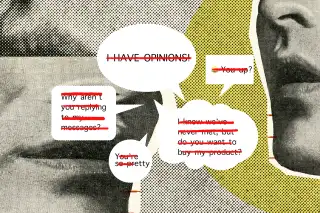Hey, Stop Being Weird on LinkedIn

At its core, LinkedIn has always positioned itself as the prim-and-proper social network — the corporate aunt to Instagram’s brand of selfies and food photos. It’s there to do its job (by helping you do yours).
But there are times when LinkedIn feels less “corporate slick,” more slimy.
Spammy connection requests are on the rise from bogus users trying to inflate their contact lists. And if you’re a woman who’s been hit on by a guy via LinkedIn, you’re not alone: This happens so frequently it’s become a meme.
Avid Money readers already know how to build a "must hire" LinkedIn profile. Now let’s review what NOT to do, based on some real-life horror stories.
DON’T: Treat it like Tinder
A few months ago, over a few glasses of Gamay, four friends told me about the various men who have “slid into their LinkedIns.” All four had received inappropriate messages about their looks and relationship status. One had to block a stranger who asked for nudes.
After putting out a call to social media, I was flooded with similar stories.
Becky Beach, a Dallas, Texas-based designer and blogger, tells me she’s been LinkedIn DMed by multiple men who ask her on dates — and who don’t seem put off when she tells them she’s married.
“[One] kept persisting that I meet him for coffee, so I had to block him,” she says, “I started not accepting any connection requests from men unless I know them.”
It’s not always that simple. For many women, particularly those who work as consultants or creative freelancers, not accepting a LinkedIn request could be bad for business.
“I have gotten several messages that start, ‘I am not being inappropriate, but you are a beautiful woman …’” says Tiffany Dyba, a New York City-based professional career coach. “I changed several privacy settings but then changed them back. As an entrepreneur in the career space, people need [access] to me and my content."
From the wage gap to the motherhood penalty, women have enough to worry about without having to choose between fielding scuzzy LinkedIn pickup lines or never logging into the network again.
So stop sending them.
DON’T: Share what isn’t yours
LinkedIn is a modern social media platform, but some long-held job seeking advice holds true: Don’t talk smack about the people you work with, or share any opinions you wouldn’t want a future boss to see. And be careful about how your sharing might affect other people — it could get them, or you, fired.
“I once had a LinkedIn connection tag me in a post about a networking event. He must have seen my name tag on the check-in table,” says Lauren Faby, a communications consultant based in Naples, Fla. “Problem was, my plans had changed due to a huge deadline. I had to field calls from my boss asking why I was at a bar when I should have been getting my work done. I was at work.”
Don’t share sensitive information about your current company, like last month’s marketing numbers, or your boss’ opinion on the CEO. And definitely don’t tag people without their permission.
DON’T: Undermine your reputation
Every day, my LinkedIn notifications get bogged down by people trying to cold sell me content marketing tools and resume reviews. Most are blatant form emails; some are 10 paragraphs long.
LinkedIn is a professional network for — get this — networking. So request to connect for the right reasons. Save the sales spiels for later, when you’re sure the person is in your target market, and might actually be interested in buying what you’re selling.
Same goes for strong opinions, obnoxiously held.
“A male connection — ironically a resume writer and career coach — sent me multiple messages picking apart my articles,” says Marietta Gentles Crawford, a writer and personal brand strategist based in New York City. “[He] proceeded to harass me via my website contact form when he figured out that I blocked him.”
The best dialogues on LinkedIn come from open communication and give-and-take. Participate as much as you can, but make sure you’re doing just as much listening.
And if you feel entitled to tell others how they should do their jobs, sit yourself down.
“If you wouldn't want your behavior captured by someone who is your target audience, or beyond, don't do it,” Crawford says. “Nothing is truly ‘erasable’ on social media.”
DON’T: Be afraid to report bad behavior
There’s a difference between LinkedIn messages that are obnoxious, and those that are malicious.
If you’re seeing something that crosses the line — like the aforementioned “Are you married?” DMs — you should block the offender and report them to LinkedIn. (There’s an option to report a profile at the top right side of your message thread where you see the three dots.)
“It’s absolutely unacceptable for someone to harass another person on LinkedIn,” says Suzy Owens, LinkedIn’s Director of Corporate Communications, Consumer Products. “This includes romantic or sexual advances, bullying, trolling, unwanted repeated contact, or other similarly inappropriate messages.”
Last year, LinkedIn released its first transparency report outlining how it’s addressing these issues. They’ve also taken steps to make it easier to report inappropriate and spam accounts by creating and promoting educational videos that walk through the reporting process and privacy controls.
“Our members place their trust in us,” Owens says. “We work every day to protect them and make sure that LinkedIn remains a safe, trusted and professional community.”